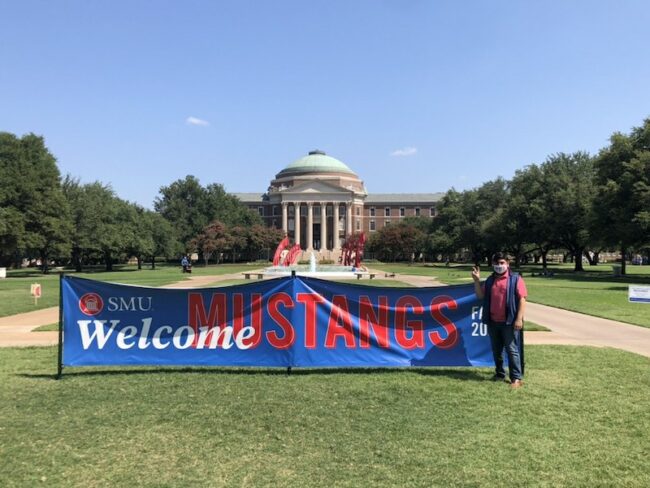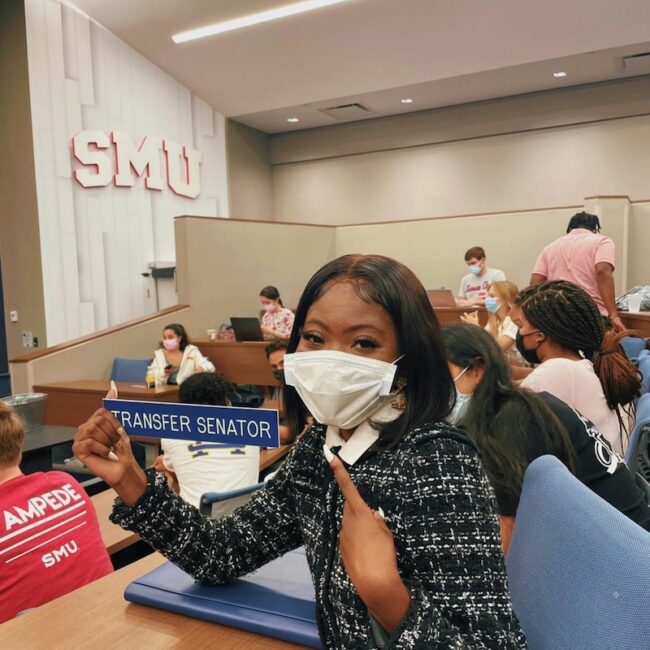Freshman year in college might be one of the most challenging years of someone’s life. Making friends, figuring out campus and understanding resources is a struggle for those new to college life.
Imagine having to do it twice.
That is the conundrum of a transfer student. Students who transfer from a 2-year community college or a 4-year university are once again in the shoes of a confused freshman. They often don’t know anyone and aren’t familiar with campus, but they are usually not treated with the same patience that a freshman may receive.
Transfer students often struggle to assimilate to their new campus, and may feel a sense of separation from non-transfer students. For some SMU transfer students, this divide was most noticeable during orientation. Transfer student and political science major Justin Valdez felt that Stampede week prioritized incoming freshmen over transfers.
“I think their priority needs to be more focused on incoming students as a whole, and putting the transfer students with them,” Valdez said.
The transfer student experience begins long before Stampede. Some research advocates for preparing students during high school for the reality of college to prevent difficulties in admissions processes. For the students beginning their second expedition through the application process, the goal is to reach post-acceptance advising and class planning. Transfer students like Diego Garcia found that their struggle began after they were accepted.

“I had a lot of trouble with financial aid,” Garcia said. “I think I’ve heard that from a lot of other students.”
At SMU, roughly one in every 11 students is a transfer student. With a student population of only 12,391, transfer students represent a significant portion of the student body. More than 45% of those transfer students come from in-state, 2-year community colleges, with Dallas College and Collin College at the top of the list.
Moving your academic journey from a community college to a university often requires significant adjustment. 22-year-old Karrington Bennett felt this way when she left Dallas College to attend SMU.
“I transferred from a community college and the atmosphere of learning is so different,” Bennett said. “Coming from a community college, things were very easy. I know when I say, ‘Oh my gosh, it’s so hard’, you’re like, ‘duh’, but I feel like I wasn’t really prepped to come in to this.”
Bennett was recently elected to serve as the 108th Transfer Student Senator in the SMU Student Senate. Her own experiences and those of her peers encouraged her to make improving the transfer student experience a priority.
“I felt like I could share my peers’ voice as far as getting the things that we need to succeed here,” Bennett said.

Bennett identified challenges for transfer students such as scholarship availability, on-campus representation and locating resources. She hopes to utilize her time in the student senate to make a long-lasting impact on these issues.
“Ultimately my goals are to improve the transfer experience for the students here now and the students after me,” Bennett said. “I want to specifically improve the disconnect between transfer students and the entire student body.”
While some transfer students are identifying ways to improve their experience, others are taking advantage of resources already being offered. This is true for 30-year-old junior Shaye Grant, who transferred from Dallas College to continue her journey towards law school.
“I think if a transfer student is feeling like there is not enough resources, I don’t think they’re utilizing what is offered to them,” Grant said.
Other transfers may not share that sentiment. Both Valdez and Bennett share the opinion that there are still things to improve upon in the transfer experience. Despite the trials in the transfer process, there is still a positive consensus on the value of the SMU experience.
“You are getting the best of the best here, without a doubt,” Valdez said. “I can attest to that. The people here are great.”
National transfer enrollment has declined since the beginning of the pandemic, and SMU’s enrollment followed suit. Enrollment rates for transfer students dropped 15% in spring 2020 and 5% the following fall, compared with enrollment rates from the prior year. The experience of a transfer student was further rocked for students like Garcia and Valdez who began their SMU experience with the fully remote semester of fall 2020.
“It mostly felt like I transferred and then it just went straight to classes, just because there wasn’t that social aspect,” Garcia said.
Students like Garcia used university-sponsored virtual events to connect with other transfer students and create opportunities for connection remotely. Garcia, Valdez, and Grant are all part of a transfer student GroupMe chat totaling more than 100 members.
“Without transfer group chats, I probably wouldn’t have met anybody last semester because of Covid,” Garcia said.
Prior to the onset of the pandemic, SMU has been building on its strategic plan for growth and development to better support all students. To supplement this progress, the university established the Task force for the Transfer Student Experience during the past summer. This task force, led by co-chairs Melinda Carlson and Dr. Sheri Kunovich, worked with faculty, staff and undergraduate transfer students to identify key elements of the transfer experience that could be improved upon.
“We’re looking at the extent to which they get a full SMU experience as a transfer student,” Dr. Kunovich said.
In their research, the taskforce identified “transfer student champions” as offices, groups and individuals on campus that have made a commitment to the inclusion of transfer students. Dr. Kunovich pinpointed SMU libraries and the Transfer Student Services team as examples of the on-campus champions.
The recommendations made by the taskforce regarding the transfer student experience will be submitted to the Provost later this year, and used as a part of the 10-year strategic plan to improve SMU. The plan details improvements in recruitment and diversity, and is expected to be completed in 2025.
“I think it’s important that we all remember that we made this commitment and we knew it was going to take us 10 years to get there,” Dr. Kunovich said. “We’ve accomplished several of the outcomes, but there are other outcomes that we just need to keep moving forward on.”
To hear more from the conversation with Transfer Student Senator Karrington Bennett, listen here.














